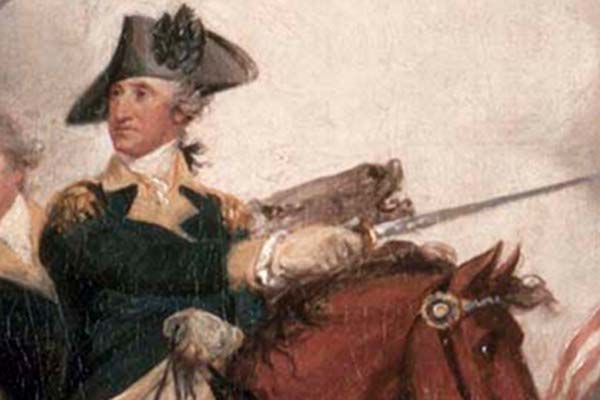It is easy to forget that the dignified eighteenth-century gentleman whose image appears on the one-dollar bill, the first President and father of his nation, owed his position entirely to his prowess as a soldier. Stephen Brumwell’s book charts the two phases of his military career, firstly fighting for King George II, then fighting against King George III.
George Washington was born into a landowning family in Virginia and was expected to become a gentleman planter like his forebears. But the appeal of adventure on the frontier drew him to enlist – with no formal military training ‒ as a militia officer. Five years of tough campaigning followed, defending the western fringes of Britain’s colonies against encroachment by the French and their Indian allies. At the age of just twenty-two, Washington was appointed colonel of the Virginia Regiment, and he experienced all the horrors of war, including the torture and scalping of prisoners by tribesmen on both sides, before the frontier was finally pacified and the French repelled. The French and Indian War was his military apprenticeship: it taught him about planning and logistics, how to improvise tactics on difficult terrain and how to keep a disparate force together through training and hard discipline. But although he wore King George’s red coat, he had, as a mere colonial militia officer, to take orders from British regulars even of lower rank ‒ and this he greatly resented.
Still only twenty-six when he resigned his commission, Washington spent the next seventeen years as a fox-hunting gentleman farmer and member of Virginia’s assembly, the House of Burgesses. But when the American colonies rose in rebellion, the Second Continental Congress appointed him Commander-in-Chief of their so-called Continental Army. America’s new general had done no soldiering for almost two decades and had never commanded more than 1500 men, but he had a number of things going for him. Firstly, he looked the part ‒ over six feet tall, strongly built, a superb horseman ‒ and exuded good breeding and calm authority. Secondly, he had emerged from his early career on the frontier with a reputation for personal bravery and a name as a solid organiser and a cautious tactician. Thirdly, he was known to and trusted by the leaders of Congress.
Despite the eventual victory of his army, the Revolutionary War was far from plain sailing for Washington. He was perennially short of men and had to deploy short-service militia instead of the regular regiments he pleaded for; his armies were poorly supplied with food and munitions; his subordinates frequently disobeyed orders; there were jealousies and disagreements among forces drawn from the different provinces. But his insistence on training and tough discipline kept the Continental Army fighting; the spectacular victory at Trenton was entirely his doing; his presence throughout the desperate winter of 1777/8 at Valley Forge kept his army together; and his gentlemanly style smoothed the path of cooperation with the Americans’ French allies.
The bulk of Brumwell’s book is a detailed narrative of Washington’s early exploits against the French and Indians and of his campaigns in the Revolutionary War. The story is competently told, and if military history is your thing, it is the sort of thing you will enjoy ‒ although more maps would have helped the reader follow the action. Brumwell explores how the young Washington’s character was shaped by British models of aristocratic behaviour ‒ a search for military glory, the importance of personal honour, an insistence on rank and obedience. He also shows how Washington transferred a British model of military organisation to his fledgling Continental Army.
But a full picture of the man does not really emerge, perhaps because the subject is only Washington the warrior. How did the man of property, the warrior, the statesman connect with each other? Why did the man of property come to take the rebels’ side rather than remain a loyalist? How did the warrior lay down his arms? How did the statesman view the military? These are questions the book does not answer ‒ but as a straightforward account of George Washington the gentleman warrior it does exactly what it says on the tin.
George Washington: Gentleman Warrior by Stephen Brumwell (Quercus, £30)






Comments